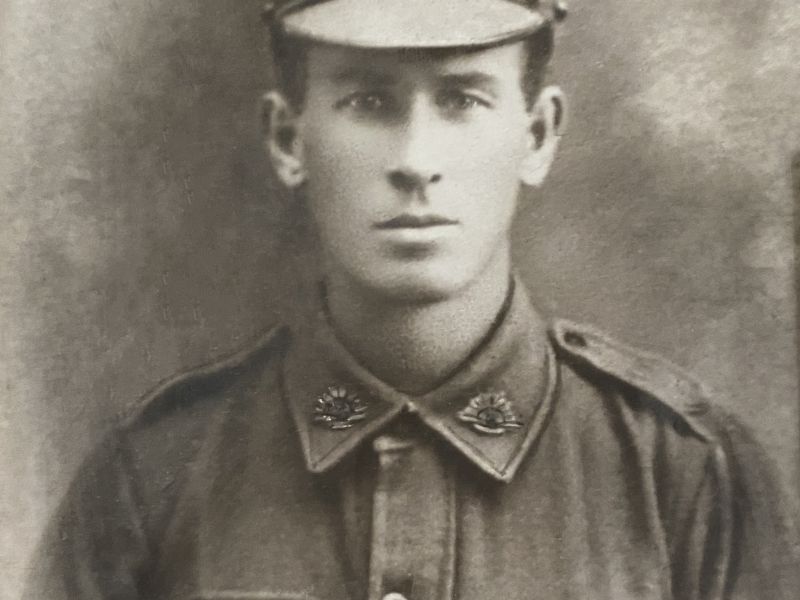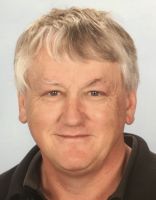John (Jack) Barnes Evans
John Barnes Evans was born in Thougla in the Upper Murray in 1883. He was one of eight children of David and Phillipa Anne (née Eade) Evans. Davids parents, Joseph and Alice were amongst the earliest white settlers in the Upper Murray, arriving during the early 1850s.
In 1906, John married Audrey Valetta Grace Supple. A year after their marriage, their first child, Ivor John Horace, was born in Cudgewa on the 11th of August. The family then moved to the Campelltown region in NSW. Here, their next two children, David John in 1907 and Ellen Valetta in 1911, were born. It’s unclear where the family was living at the time of the birth of their third son, Victor Henry in 1915.
On the 7th of March 1916, John enlisted at Victoria Barracks in Sydney. At the time the family lived in Connelly St in Penhurst, Sydney. John was 32 years old and gave his profession as a fitter. Athough it doesn’t state whether he was an electrical or mechanical fitter, his position as a signaller in the Army suggests the former. John must have thought long and hard about his enlistment, especially with a young family. His decision could have been based on the death of his brother-in-law, William Supple, in September of 1916. Perhaps he had decided that it was time to “do his bit”.
John and Audrey must have decided that whilst John was away, the family would go to live with John’s family at Berringama as this was noted as a change-of-address in John’s enlistment papers.
On the 23rd of March that year, John joined C Company of a Training battalion at the Dubbo Showground in central NSW. John remained here for about one month, training in the basics of being a soldier and becoming used to the Army routine. In mid April John was transferred to A Company of the 14th Reinforcements for the 20th Battalion. For the next six months he would undertake more training at the Liverpool Army Base just outside of Sydney.
Private John Evans, and the rest of the 14th Reinforcements, embarked on HMAT A18 Wiltshire at Sydney on the 22nd of August 1916. In a little under 2 months he disembarked at Plymouth and marched in to No. 3 Command Depot at Woolwich in the UK. Over the next three months John would between a number of training battalions, learning and practising the specific skills that he would need at the front in France.
On the 16th of January 1917 John proceeded overseas to France on HMT Princess Clementine. Although a Belgium cross channel paddle steamer, the Princess Clementine was lent to the British Government after the German occupation of much of Belgium in May 1915. The once luxurious state rooms and cabins were fitted out for transporting troops and later, for us as a hospital ship.
Having arrived in France, John marched in to the 2nd Australian Division Base Depot at Etaples. It is noted in John’s file that he was initially sent to the Segregation Camp at Etaples. This was situated in the far north-east of the camp, well away from the remaining buildings. It is not noted in John’s file the reason he was sent here, although it is known that soldiers were quarantined in this camp if they had, or were believed to have, an infectious disease.
It was not until the 12th of March that John was released from the Segregation Camp and joined the remainder of his unit. Five days later, on the 17th of March, John was taken on strength with the 20th Battalion of the 2nd Australian Division. At the time The battalion was stationed in the Bapaume region of France.
From February 1917, the German forces facing the Australians began withdrawing to the Hindenburg Line. (The Germans had been constructing heavy defensive positions along this line during the winter of 1916-1917.) The Australians pursued them and there was heavy fighting around a network of small villages. As John was joining his unit, Australian troops had reached the outskirts of Bapaume. The Allied forces believed that they had the Germans on the run. Unfortunately, the Germans were staging a voluntary withdrawal to much stronger and better prepared positions. It was against these solid defences at a point near the Bullecourt that four Australian Divisions, one after the other, were thrown during April and May of 1917. The following battles would see approximately 17000 British, Canadian and Australian troopsbeing sacrificed to capture the village and nearby trenches with 4124 of those soldiers being killed and listed as missing with no known grave. John would be amongst that number.
In John’s Australian Red Cross Society Wounded and Missing Enquiry Bureau file, there is an account of what happened to John from a number of sources that were near him when he was killed. Stretcher Bearer Alan Grant (5344) of Hobart, Tasmania provides us with the most detailed account.
“He was a signaller. I knew him well. He came from N.S.W. He was about 5ft.6” in height and well built, a well educated and smart man. He was killed in a Sunken Road running parallel with a village called Lagnicourt ont e 15th April. The germans broke through two battalions of the 1st Division. He was in a dugout and a shell fell on it and killed him and 5 other signallers. I saw it happen and he was blown up and killed instantly. I went up and looked at the six men. I was able to identify Evans without doubt, though he was much disfigured. He was a particular pal of mine and I could tell by the way his putties were done up and a little signallers badge that he used to wear on his shoulder. I also saw his disc and paybook taken off by the C.S.Major [Company Sergeant Major]. He and the other 5 signallers were buried by the Padre the same afternoon, who held a little service and afterwards a cross was erected with their names on it, but I did not see the cross as we evacuated soon after.”
John is remembered on the Australian War Memorial Roll of Honour, the Corryong War Memorial and the Villers-Bretonneux Memorial. For his service, he was awarded the British War Medal and the Victory Medal.
On the 31st of October that year, a brown paper package arrived at Berringama where Audrey and the children were living. It contained the following items; wristlet watch and strap, money belt, purse, 2 pencil cases (metal), steel mirror, diary, leather match box, key, testament, note book, letter, 2 badges, pair of scissors, 50 centimes note (damaged), religious medallion, buller, 3 coins and a souvenir coin. All the worldy possessions of Private John Barnes Evans.
In 1923, Audrey married David McCall, a cartage contractor from Sunshine, on the outskirts of Melbourne. Audrey and David would add two more daughters to the family, Alice in 1924 and Audrey Francis in 1925. Audrey would pass away in Bright in 1978.

 Stephen Learmonth
Stephen Learmonth